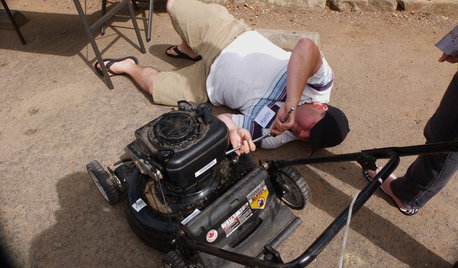Landscape Fabric Before Mulch
paso
13 years ago
Related Stories

GARDENING GUIDESHow to Pick a Mulch — and Why Your Soil Wants It
There's more to topdressing than shredded wood. Learn about mulch types, costs and design considerations here
Full Story
GARDENING GUIDESNew Ways to Think About All That Mulch in the Garden
Before you go making a mountain out of a mulch hill, learn the facts about what your plants and soil really want
Full Story
GARDENING AND LANDSCAPINGWhat to Know Before You Buy Teak Outdoor Furniture
Learn about finishes, weathering, care and that age-old oil debate to get the teak furnishings that suit you best
Full Story
FRONT YARD IDEASBefore and After: Front Lawn to Prairie Garden
How they did it: Homeowners create a plan, stick to it and keep the neighbors (and wildlife) in mind
Full Story
FARM YOUR YARD6 Things to Know Before You Start Growing Your Own Food
It takes time and practice, but growing edibles in the suburbs or city is possible with smart prep and patience
Full Story
MOST POPULAR8 Questions to Ask Yourself Before Meeting With Your Designer
Thinking in advance about how you use your space will get your first design consultation off to its best start
Full Story
LIFE7 Things to Do Before You Move Into a New House
Get life in a new house off to a great start with fresh paint and switch plates, new locks, a deep cleaning — and something on those windows
Full Story
CONTRACTOR TIPS10 Things to Discuss With Your Contractor Before Work Starts
Have a meeting a week before hammers and shovels fly to make sure everyone’s on the same page
Full Story
EVENTSDon't Throw Away Another Household Item Before Reading This
Repair Cafe events around the world enlist savvy volunteers to fix broken lamps, bicycles, electronics, small appliances, clothing and more
Full Story
REMODELING GUIDESConstruction Timelines: What to Know Before You Build
Learn the details of building schedules to lessen frustration, help your project go smoothly and prevent delays
Full Story






Kimmsr
gardengal48 (PNW Z8/9)
Related Professionals
Piqua Landscape Architects & Landscape Designers · Signal Hill Landscape Architects & Landscape Designers · Newcastle Landscape Architects & Landscape Designers · Medford Landscape Contractors · College Park Landscape Contractors · Fridley Landscape Contractors · Tuscaloosa Landscape Contractors · Vancouver Landscape Contractors · Watertown Landscape Contractors · Winchester Landscape Contractors · East Norriton Landscape Contractors · Palos Heights Landscape Contractors · Boone Decks, Patios & Outdoor Enclosures · Leander Decks, Patios & Outdoor Enclosures · Wildomar Decks, Patios & Outdoor Enclosuresplaidbird
rhizo_1 (North AL) zone 7
greenbeans
plaidbird
rhizo_1 (North AL) zone 7
plaidbird